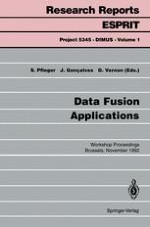
1993 | OriginalPaper | Chapter
Combining Two Imaging Modalities for Neuroradiological Diagnosis: 3D Representation of Cerebral Blood Vessels
Authors : Michael Bahner, Jürgen Dick, Bernd Kardatzki, Hanns Ruder, Matthias Schmidt, Arno Steitz, Carsten Bertram, Dietmar Hentschel, Thomas Hildebrand, Eckart Hundt, Robert Kutka, Sebastian Stier, Guido Gerig, Thomas Koller, Olaf Kübler, Gabor Szekely
Published in: Data Fusion Applications
Publisher: Springer Berlin Heidelberg
Included in: Professional Book Archive
Activate our intelligent search to find suitable subject content or patents.
Select sections of text to find matching patents with Artificial Intelligence. powered by
Select sections of text to find additional relevant content using AI-assisted search. powered by
Today the integration of information from different imaging modalities in medicine such as Computer Tomography or Magnetic Resonance Imaging (MRI) is left to the physician and gets little support from computers. In the case of neuroradiological diagnosis, information about cerebral blood vessels is available from 3D volume data from Magnetic Resonance Angiography (MRA) and from 2D images generated by Digital Subtraction Angiography (DSA). The DSA images have a higher resolution than MRA data, and therefore neuroradiologists are highly interested in a 3D reconstruction of cerebral blood vessels from different DSA projections. On the other hand, MRA contains important functional information, the velocity of blood flow. This paper describes work in progress to make available to the physician the full 3D information from both imaging modalities including an approach to 3D reconstruction from DSA im ages which makes use of the MRA data. The 3D DSA reconstruction also opens the way to an integration of information from DSA with completely different types of information, for example information on anatomical structure or soft tissue from MRI. An integral part of this work is a pilot system for clinical validation.As a typical case the neuroradiologist is interested in a 3D representation of the blood vessels surrounding an aneurysm which would significantly support a subsequent operation. To this end MRA data and DSA images are analyzed to extract information about the blood vessels such as position, orientation, width, and branchings. These items of information are input to the 3D reconstruction based on both imaging modalities. With these results physicians are able to inspect the relevant volume in three dimensions using various visualization tools including a combined display of MRA and the 3D DSA reconstruction.The envisaged benefits of this system are reduced patient risk due to shorter DSA examinations involving less X-ray and contrast agent and improved representations of the pathology leading to a better diagnosis and treatment.This work is part of COVIRA (Computer Vision in Radiology), project A2003 of the AIM (Advanced Informatics in Medicine) programme of the European Commission.1 This project started in 1992 and will last until 1994.